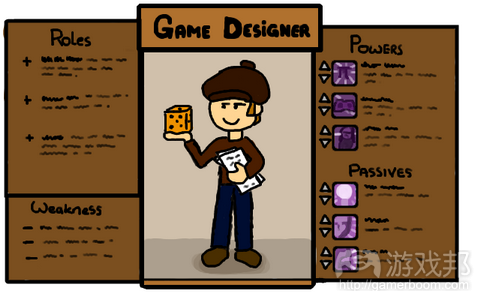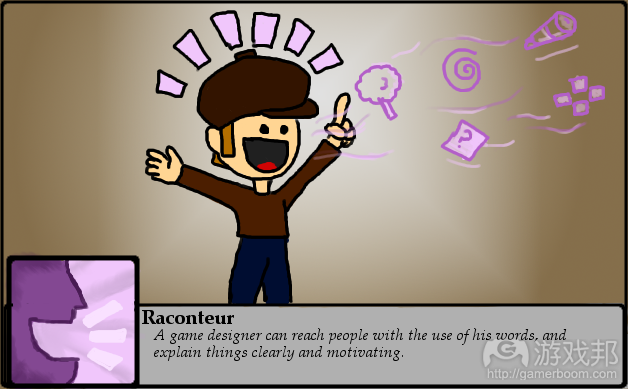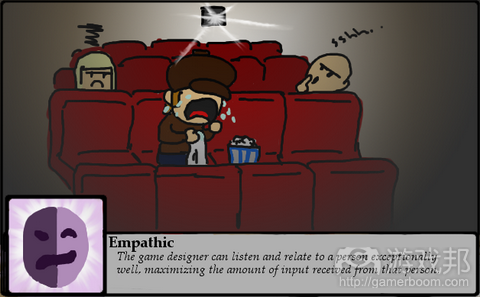阐述游戏设计师所扮演角色之素质篇(2)
作者:Adriaan Jansen
今天我们要讨论的是游戏设计师的被动技能:性格特质。我们知道各行业有都有其注重的若干品质。杰出的消防员要勇敢,富有警惕性;而优秀的护士则要有同情心,擅于照顾他人。和其他行业一样,游戏设计师也有自己偏好的品质。下面我将谈论几项我认为能够提高游戏设计技能的品质。品质是指能够进行后天提升但很难习得的天赋。例如,你是否勇敢。没有专门的学校能够教会你变得勇敢。要变勇敢很难,这需要改变你的性格。记住我提到的这些品质不是成为游戏设计师的必要条件,但这些品质能够让你有个好的开始。(请点击此处阅读本系列第1、3部分)
优秀谈论者/写作者
显然若你想要进行广泛交流,首先要有沟通技能。你需要同其他设计师、程序员、美工、商业人士、发行商,有时甚至是自己的目标用户进行沟通。假设你需要开个小组会议,在会上向团队成员介绍某个游戏机制。若你的讲话缺乏热情,索然无味,那么成员多半会转移注意力。他们会曲解你的看法,或者甚至会觉得你的内容枯燥乏味,因为你的讲话很沉闷。若你的表达含糊不清,那么听者将一头雾水,会曲解内容。和团队成员沟通要像撰写游戏设计文稿一样,确保内容简洁明了。若读者能够准确把握内容,那么整个试验过程就会缩短很多。
能够用话语打动他人对游戏设计师来说是项很重要的技能。你是唯一能够向团队成员解释执行内容的人员。所以你得确保这项工作顺利完成。若游戏构思没有得到合理的执行,那么原因应该是内容有欠妥当,而不应是你的表达令人丧失兴趣。同样,若游戏构思执行有误,那么你的表达工作就做得不到位。
一个额外加分点是,进行良好的沟通和创造出优秀的作品存在很多共同之处。如果你能够通过语言打动人,那么你多半也能够通过游戏吸引他人眼球。
创造性
当然你还得富有创造性。你要设计的是富有趣味的新体验。创作出高质量的新体验就是创造性的定义所在。这就是全部内容?
不是的。大家通常会说:“我有个很棒的游戏构思或机制设想!”这似乎就是体现创造性的地方。虽然创造新游戏构思是创造性的有效运用,但这是鲜少出现的情况。下面就来看看创造性的运用过程:
* 创造机制和构思:假设你想要创造的是款超级英雄游戏。关于超级英雄应如何在游戏中前进,及如何将boss战斗变得精彩非凡,你有很棒的想法。这非常不错。有效运用创造性,这是个有趣的过程,遗憾的是,这只是游戏设计过程的一部分。
* 提出问题:这听起来有点可笑,但你越擅于就游戏机制和构思提出问题,你的构思和机制就会越完善。这是利用创造性形成新视角,发现新问题。和糟糕设计师的沟通通常呈现如下模式:
—游戏设计师:我有个很棒的构思X!
—你:听起来很酷!但玩家会如何操作Y内容!
—游戏设计师:呃……我还没想过这种情况……
而和优秀设计师的沟通则会以此收尾:
—游戏设计师:我也想过这个问题,玩家只需要进行Z操作!
转变视角是游戏设计的重要组成部分,这促使富有创造性的人员能够提出新看法,基于这个角度发现问题。你的原始机制定存在不足,我们需要反复地去粗取精,方能呈现出优秀的设计。运用创造性思维发现设计新视角及新问题能够有效提高你的“蒸馏”速度,进而让你能够进行更多次的迭代操作。根据循环规律,更频繁的迭代过程意味着我们将得到更杰出的产品。
* 创造合理的解决方案:既然你已通过自己的创造性发现新问题,我们是时候该运用创造性想出合理的解决方案。我所指的合理解决方案是指不会提高游戏复杂性的方案。你的游戏可以很复杂,但应该是因为游戏原本就以复杂性作为设计目标,而不应是:“这里存在某个问题,我们唯一的解决方案就是添加更多规则,应对此异常情况。”这听起来很简单,但要找到不会带来更多奇怪异常问题的解决方案要比表面上看起来困难很多。若你能够创作出不受视角变更影响,同时又不会显得特别臃肿的设计,那么你就将创造性技能发挥得很好。这是相当于程序员“整齐编码”的游戏设计。
所以设计师要保持富有创造性,但不要忘记在想出构思后充分发挥创造性。
换位思考
我们又不是要安慰他人,为什么设计师需要比其他人更懂得移情,换位思考?
当若仔细进行思考,你就会发现这合情合理。下面就来看看字典中“移情”的定义:
能够理解及通过想象深入他人的情感
当玩家在体验游戏时,他们接触的是能够赋予其某种情感的内容。例如,变成超级英雄的强大感觉,扮演邪恶霸主的孽待乐趣。有什么比进入玩家角色状态更能够深入把握玩家的体验内容?若你在游戏测试过程中发现玩家没有享受其中,那你就得探究原则所在。若你能够走出自我,将自己同角色融为一体,作用将非常显著。
我们会通过很多方式“训练”移情技能。首先,他们进行提问和倾听,进行仔细倾听。若玩家在游戏的跳跃过程中受挫,那么他会说:“此跳跃内容糟透了”这和“我似乎无法顺利完成此跳跃操作”截然不同。你也许会认为,二者都代表跳跃机制不够顺畅。但在第一种情况中,玩家责备的是游戏。而第二种情况中,玩家责备的是自己。若玩家觉得跳跃内容糟透了,那么他就会形成和目标体验相抵触的消极游戏过程。但在第二种情况下,游戏不见得就是个糟糕体验,因为玩家觉得自己处在控制地位。有些游戏采用逐步提高玩家操作水平的模式,即便控制装置处于一流水平(游戏邦注:设计师要仔细倾听玩家的意见,识破他们的语言)。
理解他人情感的另一方式是,查看他/她的肢体语言、面部表情、姿势及注意力:这些都能够表现出连玩家自己都没有察觉到的动机和情感。游戏设计师常常会记录游戏测试过程,以便随后投入更多时间仔细分析玩家的肢体语言。理解及进入玩家的游戏体验中对设计师来说是项非常重要的技能。
就此来看,移情技能似乎主要用于测试目的,但在我看来,它可以运用至游戏设计过程的各个方面:
* 体验塑造过程:还记得前面提到的,运用自己的创造性探索新视角?移情技能能够帮你感受这些新视角。从根本上说,你是在同另一个自己形成共鸣,试着体会不属于自己的情感。
* 沟通:移情是沟通的核心。理解他人的观点及动机对于进行有效沟通至关重要。同样,若你能够进行仔细倾听,同团队成员形成共鸣,你们你将发现自己从未遇过的新视角、新问题及新解决方案。倾听团队成员的看法与同他们进行沟通一样重要。
* 测试&调节:和上面谈到的内容类似。
无法感受他人游戏动机及体验情绪的设计师将很难创造出吸引玩家眼球的内容。设计师所需要的品质很多,但我觉得上述3点尤其重要。(本文为游戏邦/gamerboom.com编译,拒绝任何不保留版权的转载,如需转载请联系:游戏邦)
The Game Designer Class – What is he like?
by Adriaan Jansen
Last week, I started with a series of blogposts about what it’s like and what it takes to be a game designer. Because we’re talking games here, I’m approaching these posts as an RPG character creation guide. The series consists of the following chapters:
1. Role: What are the tasks of a game designer?
2. Passive Abilities: What are favorable character traits? (This chapter!)
3. Powers: What are important skills?
4. Weaknesses: What are the biggest pitfalls?
So this week, I’ll talk about the passive abilities of the gamedesigner: the character traits. We all know some favorable character traits for a lot of professions. A good firefighter is brave and vigilant, and a good nurse is often sympathetic and caring. As with any profession, game designers have favorable traits too. Here I will give my take on the traits that will improve your game design capabilities. Traits are more like naturally born talents, that can be developed, but hardly learned. For example, you are either brave or not. There is no such thing as a brave school where you learn to be brave. Becoming brave is a difficult task, one that requires a character change. Note that these traits I mention aren’t requirements for being a game designer, but traits that, in my opinion, will give you a significant head start.
Before I start, I need to credit Jesse Schell, Extra Credits and Joost van Dongen again, for their words of wisdom that have influenced my view on game design. Some viewpoints here might be shamelessly copied from them.
Good talker/writer
Obviously, if you’re going to communicate a lot, you’ll need to be able to communicate well! You’re going to talk or write to other designers, programmers, artists, business-guys, publishers, and sometimes, even your target audience! If the way you communicate is boring, you’re bound to lose the interest of others. Say you’re having a team meeting where you’re going to pitch a mechanic to the team. When you talk as passionate and interesting as a bag of potatoes, you run the risk that the people will stop paying attention. They’ll misinterpret your idea, or worse, they’ll just won’t think your idea is fun because you’re not fun!If your way of communicating is unclear, you’re going to sow a lot of confusion and misinterpretation. When you’re communicating with the team, like writing a gamedesign document, make sure to be clear and explicit. If the reader get’s it right away, it will shorten the test loop.
Having a knack for reaching people with your words is a great talent for a gamedesigner. You’re the only one that can explain the team what has to be implemented. So make sure you do it well! If ideas don’t get implemented, you want them not to get implemented because they weren’t good enough, not because your talk was uninteresting. Also, if ideas get implemented wrong, you didn’t do your job of communicating good enough.
A nice plus is that designing a good talk has a lot of similarities with designing a good game. If you have a talent for interesting people with words, you’re more likely to interest people with games as well.
Creative
Well duh. Of course you have to be creative! You are trying to craft an exciting new experience! Making something new of high quality is the practically the definition of creativity! So we’re done here, right?
…Not entirely. People often come with:”I have an awesome idea for a game or a mechanic!”, and it seems that creativity stops there. While composing new ideas for experiences are a very valid use of creativity, they are probably the least frequent one. Remember “Experience Crafting” from the last blog? Look closely on how creativity is used there:
* Creating mechanics and concept: So you want to make a superhero game? You have great ideas for how a superhero should progress through the game, and how to awesomify the boss battles? Great! Valid use of creativity, very fun to do, and sadly, just a small part of the game design process.
* Creating problems: This sounds very silly and stupid, but the better you are at creating problems for your mechanics and concepts, the better your concepts and mechanics will be. This is creativity used to create new perspectives and finding new problems. A talk with a bad gamedesigner will go something like this:
—Game designer: I have an aaaawesome idea X!
—You: Sounds cool! But… how will the player do Y?
—Game designer: Uuuuh… I didn’t think about the idea that way….
While a talk with a good game designer would end with:
—Game designer: I already thought about that problem, and the player just needs to do Z!
Changing perspective is an important part of game designing, and it takes a creative person to come up with new perspective and seek problems from that point of view. Your initial mechanics are never perfect, and it will take many iterations to distill out the best design. Using your creativity to find new perspectives and problems in your design will improve your distilling-speed, and thus allow more iterations. By the rule of the loop, more iterations means a better product!
* Creating elegant solutions: Now that you used your creativity to find new problems, it’s time to use that creativity to come up with elegant solutions! With elegant solutions I mean solutions that don’t add to the complexity of the game. Your game can be complex, but it should be complex because you choose to make a complex game. The reason shouldn’t be: “There was this problem and the only way we could fix it was to add more rules to catch this exception.” It sounds easy, but finding a solution that doesn’t add more strange exceptions is harder than it looks. When you can make a design that is resistant to change of perspective while not becoming increasingly bloated, you’re using your creativity well! It’s the game design equivalent of the programmers “neat code”.
So be creative, but don’t forget to put that creativity to good use after the concept has been thought out!
Empathetic
Wait, what? Empathy? We’re not trying to comfort anyone! Why would a game designer need empathy more than any other human being to excel?
When you think about it a little bit longer, it makes a lot of sense. Look at the definition of empathy according to the Collins English Dictionary:
the power of understanding and imaginatively entering into another person’s feelings
When someone is playing a game, he’s entering an experience that will give him certain feelings. The feeling of power while being a superhero, or sadistic pleasures when playing an evil overlord. The point is, you as a game designer must maximize that feeling. What better way is there to understand the player’s experiences, than entering the state of the player himself? When you’re playtesting, and people do not enjoy the experience, it’s your job to figure out why. It helps a lot if you’re able to let your premises go, and identify yourself with the player.
People use many ways to “practice” empathy. First and foremost, they ask and listen, listen very closely. If the player is frustrated by a jumping course in your game, and he says: “The jumping sucks!” it means something different than if he would say “I can’t seem to get the jumping right…”. You might think that both indicate that the jump mechanics aren’t smooth enough. However, in the first case, the player is blaming the game. While in the second case, he’s blaming himself. If the player thinks the jumping sucks, he’s having a negative experience that is probably interfering with the target experience. The second case is not necessarily a bad experience, since the player feels he’s in control. There are games build around the experience of improving your mastery level, even while the controls are ace (Like Super Meat Boy and VVVVVV). Listen close to your players, and see through their words.
A second way to empathize with a person, is to look at his or her body language. Facial expression, posture, focus of attention: all these things reveal motives and feelings the player doesn’t even realize he has. It’s not uncommon for game designers to record their playtest session to have more time to analyse the player’s body language. Understanding and entering someone else’s experience is a very useful talent to have as a game designer!
Now it seems that empathy is used for testing purposes only, but in my opinion, it’s used in every aspect of game design:
* Experience Crafting: Remember to use your creativity to find different perspectives? Empathy helps you experiencing those perspectives. Basically, you’re empathizing with another fake version of yourself, trying to experience feelings that aren’t really your own.
* Communicating: I don’t think I even have to mention this, but empathy is at core of communication. Understanding someone’s views and motives is vital for good communication. Also, if you listen well and are able to empathize with your teammates, you might hear and understand new perspectives, problems, and solutions that you would have never encountered yourself. Listening to your team is just as valuable as talking to them.
* Testing & Tweaking: As mentioned above!
Someone who has difficulties understanding the motives and experiences of a person, will most likely have difficulties creating a beautiful experience.
That’s it for now! Naturally, there are many, many other traits that will help you, but I think these three are the most valuable. If you have all of them, I think you’ve got a great talent for becoming a good game designer! If you miss any of them, well, there are many roads that lead to Rome, but it will probably hamper you somewhere along the way. Next time, I’ll talk about important skills for a game designer. Thanks for reading!(Source:gamasutra)
下一篇:解析游戏趣味元素之身份和故事












































